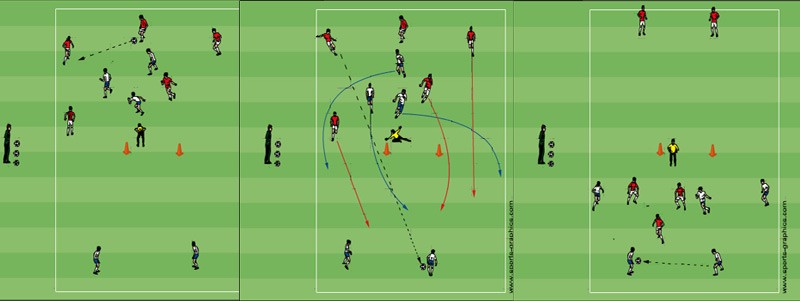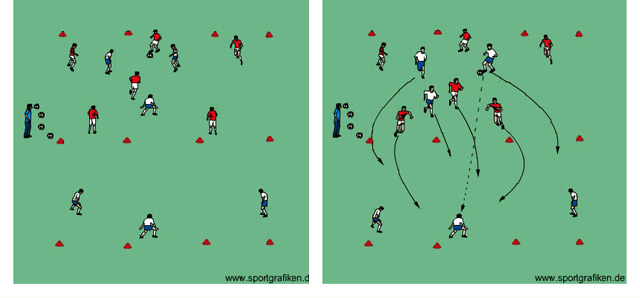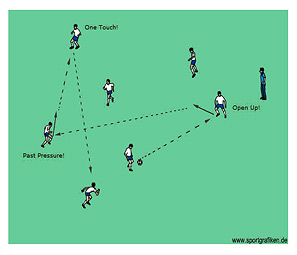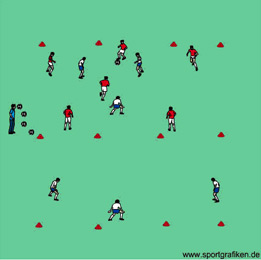Although a good practice plan follows a simple to complex progression model, I tend to build my sessions in the reverse order. The first answer that I need to arrive at when preparing a practice is the topic.
What should we work on today, this week, this month, etc.? Assuming I have the opportunity to have two training sessions per week, one practice plan will follow a curriculum-based plan where the practice is in place well in advance, and tends to fluctuate very little based on my team’s performance week to week, and instead focuses on core development aspects to help players build a skill set to meet the demands of the game over the short and long-term.
The second practice, which I’ll refer to as the team practice, and the one I will explain my preparation for in this piece, follows a different construction path. The most complex aspect of coaching, and playing for that matter, is the game itself. Analyzing what has actually taken place in the match and prioritizing what needs to be worked on in training is the starting point of my team practice plan. Very rarely, if ever, will I come away from a match and feel that there is only one thing my team needs to work on; however, it is important that when putting the practice plan together I settle on a single topic.
This provides a clear focus for me when putting pen to paper on the plan that will hopefully translate into a more effective practice session on the field for my players. Below is the typical structure of my sessions.  All of my practices end with a game and cool down (light stretch, quick review of session, any relevant updates, etc.) so there is minimal initial planning done here. Granted, I do consider the size and shape of the field and who is going to be playing with and versus whom during this segment, but in reality these things are considered after I’ve settled on my core training activity for the session.
All of my practices end with a game and cool down (light stretch, quick review of session, any relevant updates, etc.) so there is minimal initial planning done here. Granted, I do consider the size and shape of the field and who is going to be playing with and versus whom during this segment, but in reality these things are considered after I’ve settled on my core training activity for the session.
Example Topic Chosen through Match Analysis: Attacking Transition
Once I’ve selected the topic for the session, I spend a great deal of thought and care in trying to figure out what exercise will best address improvement in this area. This exercise is almost always the 2nd Activity/Match Related Activity for me. This activity is a complex activity that places players in an environment where they are forced to make decisions quickly, to perform techniques under game like pressure (promotes functional technique) and has a high resemblance to the game itself in that the players are attacking and defending in a directional manner.
Example Core Activity: Transition Game with Mirror Goal

With the core activity in place, I work backwards in my selection of the 1st activity.I try to ensure that this activity (1st activity) will “tune the players in” and create a comfort level both technically and tactically for the main activity of the session.This activity will be performed under some pressure, but not too much pressure that the players struggle to have success.If this activity is too difficult and the players get frustrated in that they can’t find a rhythm, the success of the core activity will suffer.I also like to have the set-up of this activity mirror the set up of the core activity as much as possible.This will allow for me to make slight adjustments to the set-up during a quick water break for the players, but not have to do so much adjusting that the players are waiting around that the practice tempo suffers.
Example 1st Activity:Transition Boxes
The Warm-up is the first official activity the players will experience at practice (I tend to hold a street soccer arrival prior to the warm-up), but it is the last item I put in place when preparing my plan. I view the warm-up stage as an integral time for player and team development, not an insignificant part of the session plan. To me a good warm-up should:
- Set the tone and rhythm of the practice.
- Begin on time and get the players focused.
- Provide numerous repetition to technically prepare the players for the demands of the session
- Be related and lead to more success in the activities that will follow.
Example Warm-up: Notre Dame Passing Warm-up
 This is the method I use when I build a practice plan. I’ve come to this system over time and found that it is the most effective one for me to address my team’s preparation and development. If you currently struggle with putting a plan together, I’d recommend starting from the core and working your way out. It may seem an unorthodox way of building a session, but I’ve found that the most important exercise in team preparation to be the final activity prior to the scrimmage. If I can select this activity wisely and prepare a plan that builds toward this exercise, the session will be a successful one for both the players and coaches involved in the session. Full practice plan is below.
This is the method I use when I build a practice plan. I’ve come to this system over time and found that it is the most effective one for me to address my team’s preparation and development. If you currently struggle with putting a plan together, I’d recommend starting from the core and working your way out. It may seem an unorthodox way of building a session, but I’ve found that the most important exercise in team preparation to be the final activity prior to the scrimmage. If I can select this activity wisely and prepare a plan that builds toward this exercise, the session will be a successful one for both the players and coaches involved in the session. Full practice plan is below.



